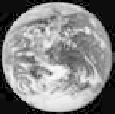Geoscience Reference
In-Depth Information
Laws 1/2: Net forces acting cause
accelerations
Law 3: Action always opposed by
an equal reaction
Conservation of linear momentum
F
= -
F
-
mg
or
-
mg
m
1
d
2
x
1
/d
t
2
= -
m
2
d
2
x
2
/d
t
2
F
or
F
d/d
t
(
m
1
d
x
1
/d
t
+
m
2
d
x
2
/d
t
)= d
p
/d
t
= 0
Forces come in pairs
and net force causes acceleration
Fig. 3.7
The force due to the spring balances the equal and opposite forces due to the product of mass and gravitational acceleration.
discontinuity, for example, between adjacent rock layers
on a mountainside outcrop or when rapid displacement
along faults occurs during earthquakes.
The inertial concept of force comes courtesy of
Newton's Second Law, the most essential and general of
his three laws and the basis of all mechanics. We give it via
the same nineteenth-century translation from the original
Latin as previously:
gravity at the Earth's surface due to the tiny differences in
gravitational accelerations brought about by changes in water
depth of the oceans or to rock density under the Earth's sur-
face: these are termed
gravity anomalies
. The gravity forces
give rise to a force
field
which shows the spatial variation or
gradient
of the magnitude and direction of the forces.
We are often much more interested in forces that act
within or upon masses of material. These give rise to
stresses and pressures (such as the hydrostatic pressure
examined in Section 3.5) on imaginary planes within a
rock or fluid mass. In this way they are defined as forces
which one gravitational mass applies to another gravita-
tional mass: we simply need to specify the defined surface
plane (with respect to coordinates) on or within a sub-
stance over which the gravity force acts. The concept of a
surface weight force due to Everest acting on a plane at
greater than 7 km elevation is illustrated in Fig. 3.8.
One important force affecting bodies in contact is the
friction force
. This is a contact force that acts to resist slid-
ing (see Sections 4.11 and 4.14 for granular flows and rock
masses respectively) and depends upon the nature (rough-
ness, physical state), but not the contact area, of opposing
surfaces.
Law 2. Change of motion is proportional to the moving
force impressed, and takes place in the straight line in which
that force is impressed.
By “change of motion” Newton is referring to the
changing “quantity of motion,” or momentum (see
Section 3.1). This is quite easy to imagine as we are all
familiar with the forces that result when moving objects
collide with stationary surfaces, the former sometimes los-
ing momentum entirely. Natural examples of total loss
would be volcanic bombs hitting soft ground of ash
(Fig. 3.9), the base of an earthquake-displaced crustal
block (Fig. 3.10) or of momentum transfer as desert rock
surfaces are bombarded by bouncing sand grains. Loss,
exchange, or change of momentum over time is
d(
m
u
)/d
t
. Change of momentum or acceleration requires
a force to produce it. We can say all this in simple terms
using the Second Law,
F
3.3.3
Inertial force and rate of change of momentum
m
a
.
Accelerations act upon mass due to
inertial forces
that
cause a change of momentum. For example, in rapidly
moving turbulent fluids, though body forces are always
present, inertial forces act causing rapidly changing vectors
of motion within the fluid. Such forces can also act on any
3.3.4
Conservation of linear momentum
When two masses interact with each other, for example,
along surface contact due to friction, equal and opposite














Search WWH ::

Custom Search